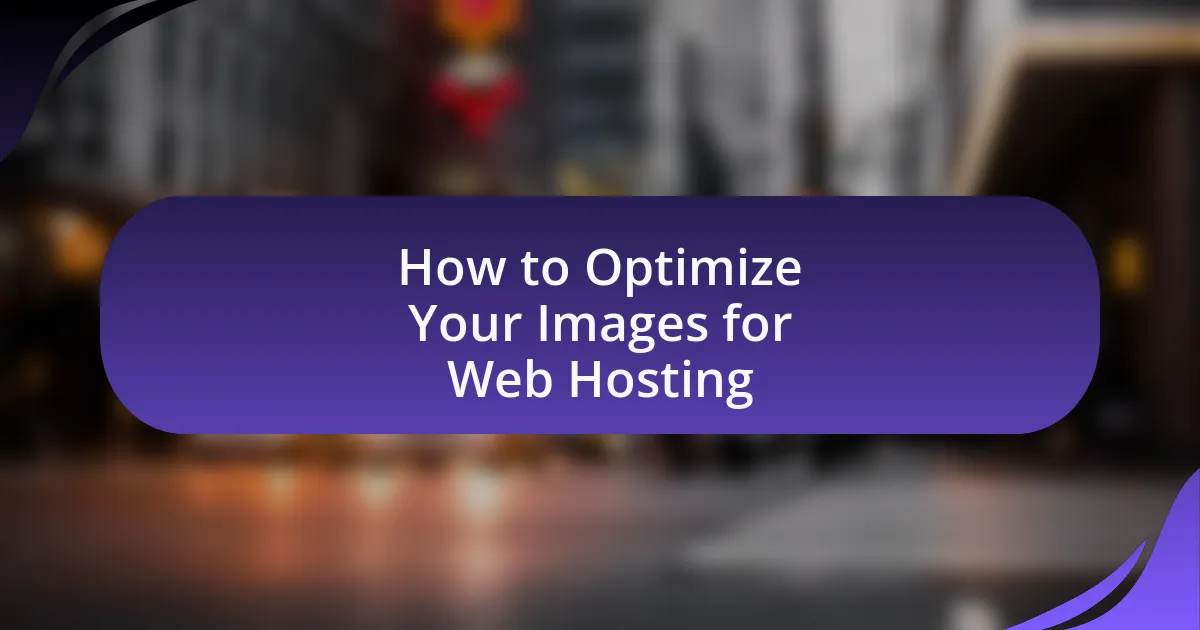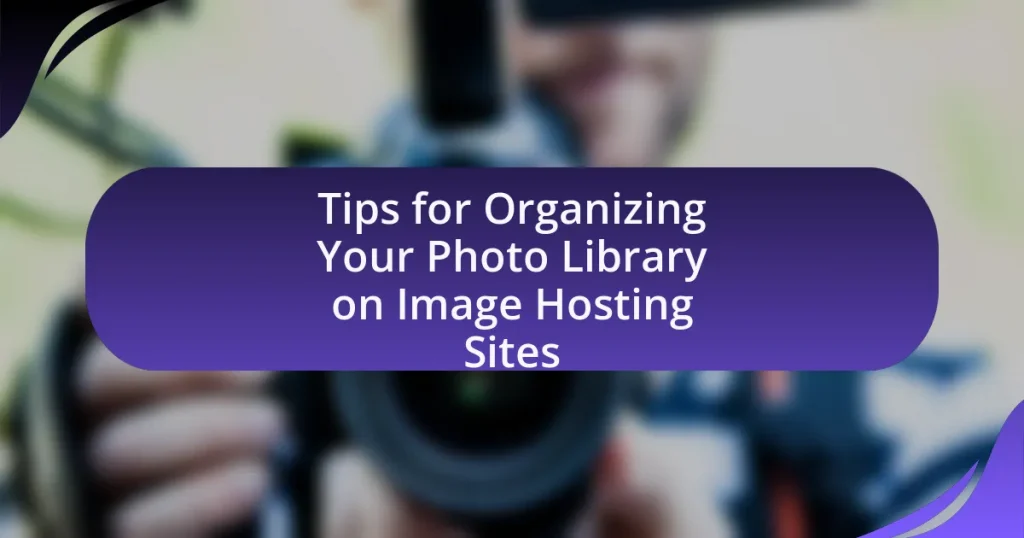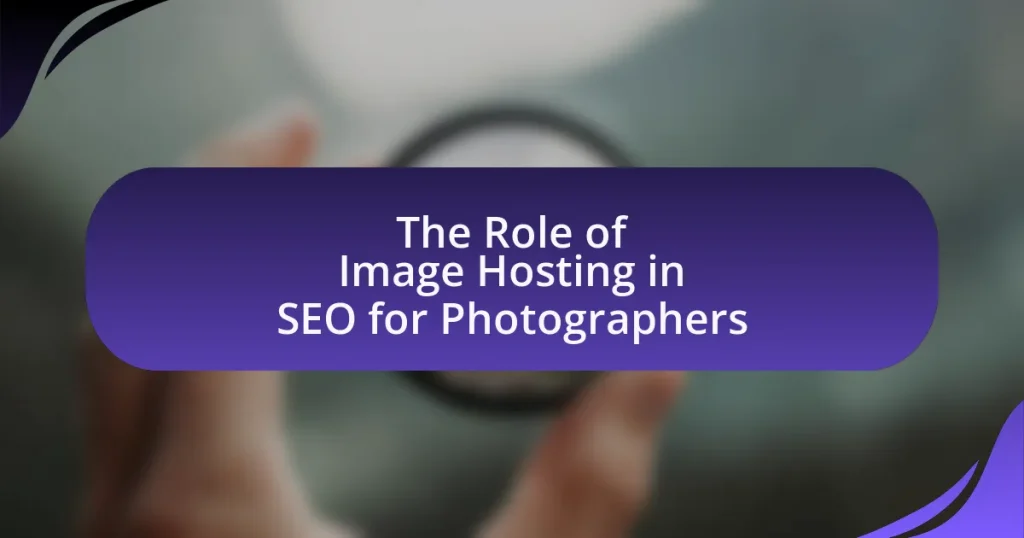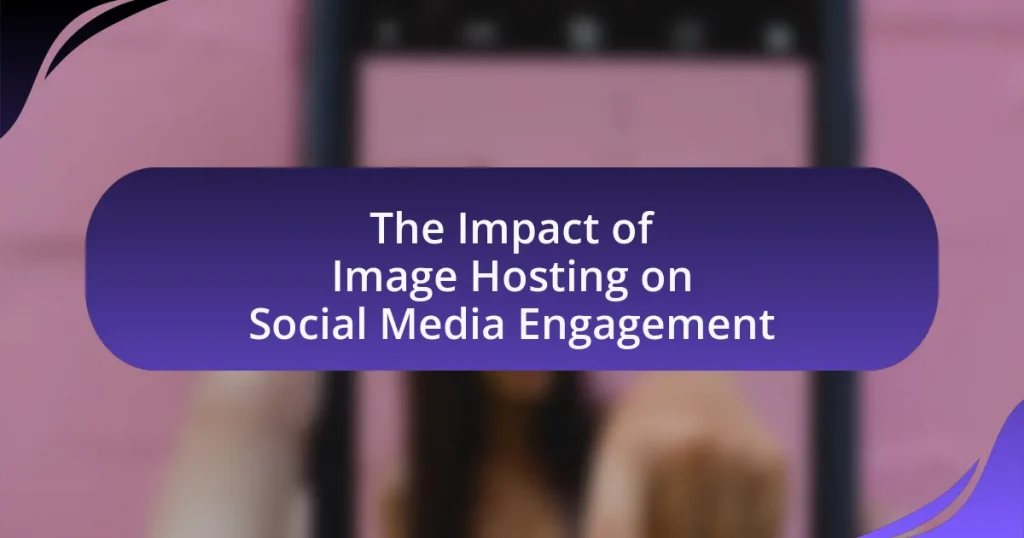Image optimization for web hosting is the process of reducing image file sizes while maintaining quality, which is essential for enhancing website performance, user experience, and search engine rankings. This article covers the importance of image optimization, the impact of image size and quality on loading speed, and the key components involved in the optimization process, including file format selection, compression techniques, and responsive images. It also discusses best practices, common mistakes to avoid, and advanced techniques such as lazy loading and the use of image CDNs to improve performance. Additionally, various tools and resources for effective image optimization are highlighted, providing practical tips for achieving faster loading times and better user engagement on websites.
What is Image Optimization for Web Hosting?
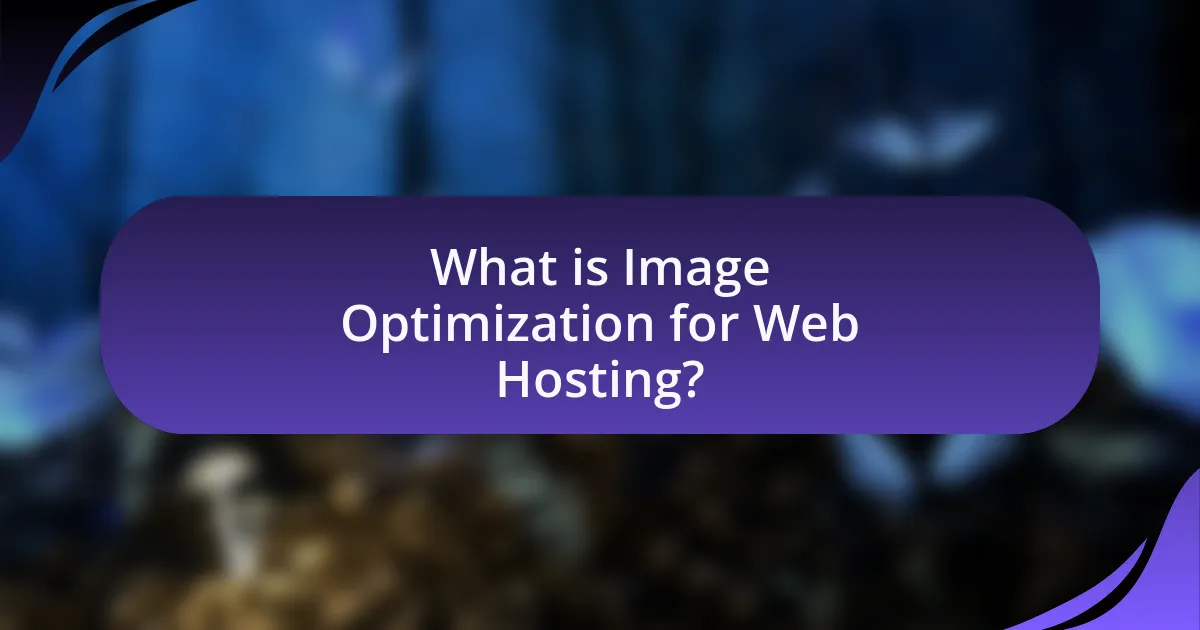
Image optimization for web hosting refers to the process of reducing the file size of images without significantly compromising their quality, ensuring faster loading times and improved performance on websites. This practice is essential because optimized images can enhance user experience, decrease bandwidth usage, and improve search engine rankings. According to Google, page speed is a ranking factor, and images often account for a large portion of a webpage’s total size, making optimization crucial for efficient web hosting.
Why is image optimization important for web hosting?
Image optimization is important for web hosting because it significantly enhances website performance and user experience. Optimized images reduce file sizes, leading to faster loading times, which is crucial as studies show that a one-second delay in page load can decrease conversions by 7%. Additionally, search engines prioritize fast-loading websites, improving search rankings and visibility. Therefore, effective image optimization not only improves user engagement but also contributes to better SEO outcomes.
How does image size affect website loading speed?
Image size significantly affects website loading speed, as larger images require more data to be transferred, resulting in longer loading times. When images are not optimized, they can slow down page rendering, leading to a poor user experience and potentially higher bounce rates. Research indicates that a 1-second delay in page load time can lead to a 7% reduction in conversions, highlighting the importance of image size in overall website performance. Therefore, optimizing image size by compressing and resizing images can enhance loading speed and improve user engagement.
What role does image quality play in user experience?
Image quality significantly impacts user experience by influencing visual appeal, engagement, and perception of content credibility. High-quality images enhance the aesthetic value of a website, making it more attractive and inviting to users. Research indicates that 94% of first impressions are design-related, underscoring the importance of visual elements in retaining user attention. Furthermore, poor image quality can lead to frustration, causing users to leave a site prematurely, which negatively affects bounce rates and overall site performance. Therefore, optimizing image quality is essential for improving user satisfaction and fostering a positive interaction with web content.
What are the key components of image optimization?
The key components of image optimization include file format selection, image compression, resolution adjustment, and proper dimensions. File format selection involves choosing between formats like JPEG, PNG, or WebP based on the image type and desired quality. Image compression reduces file size without significantly affecting visual quality; tools like TinyPNG or ImageOptim can achieve this effectively. Resolution adjustment ensures images are not larger than necessary for their display context, which improves loading times. Proper dimensions involve resizing images to match the display size on the website, preventing unnecessary data usage and enhancing performance. These components collectively contribute to faster loading times and improved user experience on web hosting platforms.
What formats are best for web images?
The best formats for web images are JPEG, PNG, and WebP. JPEG is ideal for photographs due to its efficient compression and ability to maintain quality at smaller file sizes. PNG is preferred for images requiring transparency and sharp edges, such as logos and graphics, as it supports lossless compression. WebP offers superior compression techniques, providing smaller file sizes while maintaining high quality, making it suitable for both photographs and graphics. These formats are widely supported across browsers and devices, ensuring optimal performance and user experience on the web.
How do compression techniques impact image quality?
Compression techniques significantly impact image quality by reducing file size, which can lead to loss of detail and clarity. Lossy compression methods, such as JPEG, discard some image data to achieve smaller sizes, resulting in artifacts and blurriness, especially in areas with fine detail. In contrast, lossless compression methods, like PNG, maintain original quality but do not reduce file size as effectively. Studies show that excessive lossy compression can degrade images to the point where they are visually unappealing, with a balance needed between size reduction and quality preservation. For instance, a JPEG image compressed at a high ratio may lose up to 50% of its original quality, making it crucial to choose appropriate compression settings based on the intended use.
How can you effectively optimize images for web hosting?
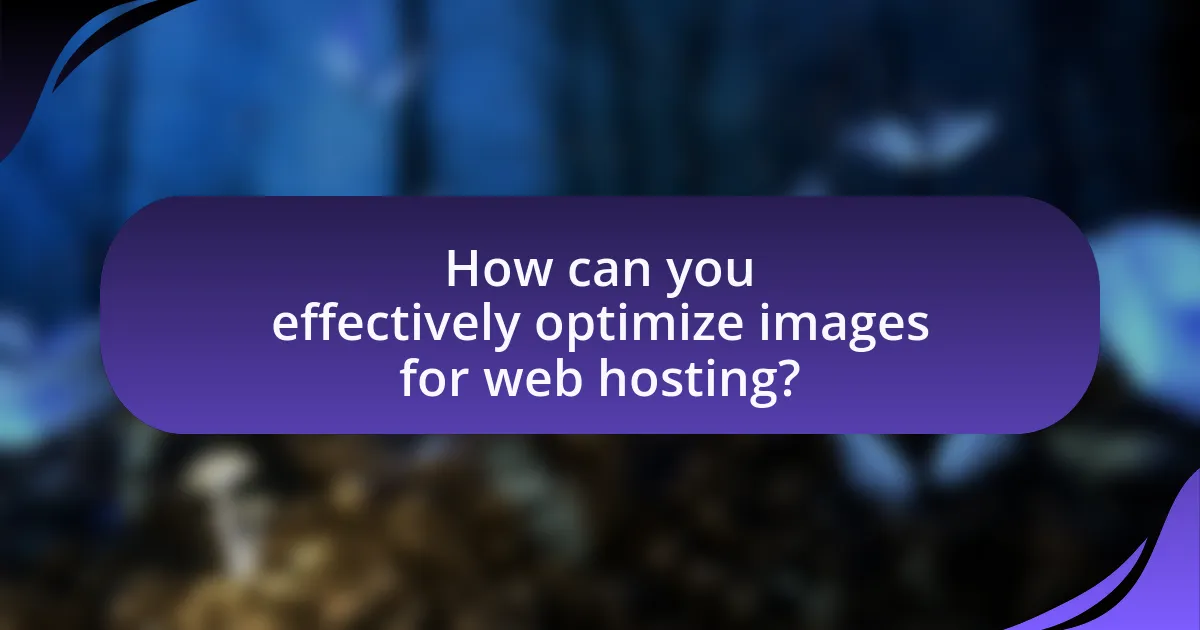
To effectively optimize images for web hosting, compress images to reduce file size without significantly affecting quality. Tools like TinyPNG or ImageOptim can reduce image sizes by up to 70% while maintaining visual fidelity. Additionally, using appropriate file formats such as JPEG for photographs and PNG for graphics ensures optimal quality and size. Implementing responsive images with HTML attributes like “srcset” allows for different resolutions to be served based on the user’s device, enhancing loading speed. According to Google, optimizing images can improve page load times, which is crucial for user experience and SEO rankings.
What steps should you follow for image optimization?
To optimize images for web hosting, follow these steps: first, choose the appropriate file format, such as JPEG for photographs and PNG for images with transparency. Next, resize images to the dimensions needed for your website, as larger images can slow down loading times. Then, compress images using tools like TinyPNG or ImageOptim to reduce file size without significant loss of quality. Additionally, add descriptive alt text to improve accessibility and SEO. Finally, implement lazy loading to defer loading of off-screen images, enhancing page speed. These steps collectively ensure faster loading times and better user experience, which are critical for web performance.
How do you choose the right image format for your needs?
To choose the right image format for your needs, assess the purpose of the image and the required quality. For web hosting, JPEG is ideal for photographs due to its balance of quality and file size, while PNG is better for images requiring transparency or sharp edges, such as logos. GIF is suitable for simple animations but has a limited color palette. According to a study by Google, using the appropriate format can reduce loading times by up to 50%, enhancing user experience and SEO performance.
What tools can assist in compressing images?
Tools that can assist in compressing images include Adobe Photoshop, TinyPNG, and ImageOptim. Adobe Photoshop offers advanced features for image compression, allowing users to adjust quality settings and file formats. TinyPNG is an online tool that uses smart lossy compression techniques to reduce image file sizes without significant loss of quality. ImageOptim is a desktop application that optimizes images for the web by removing unnecessary metadata and applying lossless compression. These tools are widely recognized for their effectiveness in reducing image sizes, which is crucial for optimizing images for web hosting.
What best practices should you implement for image optimization?
To optimize images effectively for web hosting, implement the following best practices: use appropriate file formats, compress images, and utilize responsive images. Using formats like JPEG for photographs and PNG for graphics ensures quality while maintaining smaller file sizes. Compression tools can reduce image sizes without significant loss of quality; for instance, tools like TinyPNG can decrease file sizes by up to 70%. Additionally, employing responsive images through the ‘srcset’ attribute allows different image sizes to be served based on the user’s device, enhancing loading speed and user experience. These practices collectively improve website performance and SEO, as Google considers page speed in its ranking algorithms.
How can you maintain image quality while reducing file size?
To maintain image quality while reducing file size, utilize image compression techniques that balance quality and size. Lossless compression methods, such as PNG or TIFF formats, preserve image quality while minimizing file size, making them ideal for images with sharp edges and text. Additionally, using lossy compression formats like JPEG allows for significant file size reduction while maintaining acceptable quality for photographs. Tools like Adobe Photoshop, TinyPNG, or ImageOptim can effectively compress images without noticeable loss in quality. Research indicates that optimizing images can reduce loading times by up to 70%, enhancing user experience and SEO performance.
What are the common mistakes to avoid in image optimization?
Common mistakes to avoid in image optimization include using incorrect file formats, neglecting to compress images, and failing to use descriptive alt text. Using formats like BMP or TIFF instead of web-friendly formats such as JPEG, PNG, or WebP can lead to unnecessarily large file sizes. Neglecting compression can result in slow loading times, negatively impacting user experience and SEO; tools like TinyPNG or ImageOptim can effectively reduce file sizes without significant quality loss. Additionally, failing to include descriptive alt text not only affects accessibility but also diminishes SEO potential, as search engines rely on this text to understand image content.
What are the advanced techniques for image optimization?
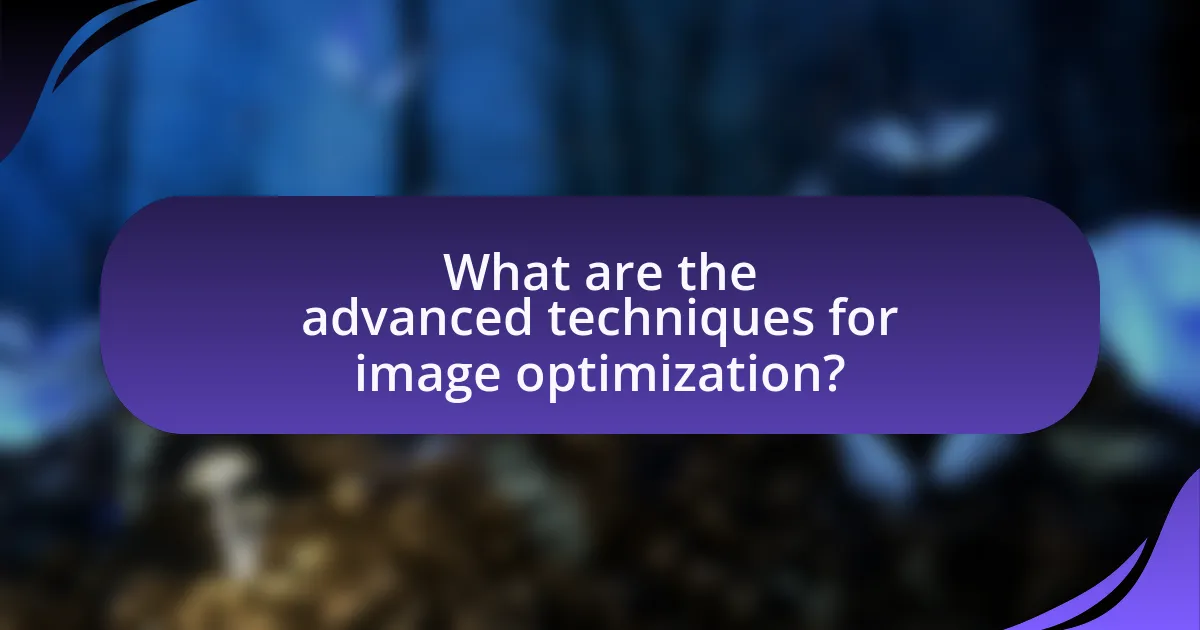
Advanced techniques for image optimization include lossless compression, responsive images, and lazy loading. Lossless compression reduces file size without sacrificing quality, utilizing algorithms that maintain the original image integrity, which can improve loading times and user experience. Responsive images adapt to different screen sizes and resolutions, ensuring that the appropriate image size is delivered based on the user’s device, thereby optimizing bandwidth usage. Lazy loading defers the loading of images until they are in the viewport, which enhances initial page load speed and reduces unnecessary data usage. These techniques collectively contribute to improved website performance and user engagement.
How can responsive images enhance user experience?
Responsive images enhance user experience by ensuring that images are displayed at optimal sizes across various devices, improving load times and visual clarity. When images automatically adjust to fit the screen size, users experience faster loading times, which is crucial as studies show that a one-second delay in page load time can lead to a 7% reduction in conversions. Additionally, responsive images maintain visual quality, preventing pixelation on larger screens and ensuring that users on mobile devices do not have to scroll horizontally. This adaptability leads to increased user satisfaction and engagement, as users are more likely to stay on a site that loads quickly and displays content clearly.
What is the role of lazy loading in image optimization?
Lazy loading plays a crucial role in image optimization by deferring the loading of images until they are needed, which enhances page load speed and reduces initial data consumption. This technique improves user experience by allowing the visible content to load faster, as images that are not immediately in the viewport are not fetched until the user scrolls down. Studies have shown that implementing lazy loading can lead to a significant decrease in page load times, with some reports indicating improvements of up to 50% in loading speed for image-heavy websites.
How can you utilize image CDNs for better performance?
Utilizing image CDNs can significantly enhance performance by reducing load times and improving user experience. Image CDNs distribute images across multiple servers globally, allowing users to access images from the nearest server, which minimizes latency. According to a study by Akamai, reducing load time by just one second can lead to a 7% reduction in conversions, highlighting the importance of fast image delivery. Additionally, image CDNs often provide automatic image optimization features, such as compression and format conversion, which further decrease file sizes without sacrificing quality. This optimization can lead to faster page rendering and improved SEO rankings, as search engines favor faster-loading websites.
What tools and resources are available for image optimization?
Tools and resources available for image optimization include software applications and online services designed to reduce image file sizes while maintaining quality. Popular tools include Adobe Photoshop, which offers advanced compression options, and GIMP, a free alternative with similar capabilities. Online resources such as TinyPNG and ImageOptim provide user-friendly interfaces for quick image compression without the need for software installation. Additionally, WordPress plugins like Smush and EWWW Image Optimizer automate the optimization process for websites, ensuring images are optimized upon upload. These tools are widely recognized for their effectiveness in enhancing website performance by decreasing load times and improving user experience.
Which online tools are recommended for image compression?
Recommended online tools for image compression include TinyPNG, JPEGmini, and Compressor.io. TinyPNG effectively reduces the file size of PNG and JPEG images while maintaining quality, achieving up to 70% compression without noticeable loss. JPEGmini specializes in JPEG images, offering a unique algorithm that reduces file size significantly while preserving image quality. Compressor.io supports multiple formats, including JPEG, PNG, GIF, and SVG, and provides both lossy and lossless compression options, making it versatile for various needs. These tools are widely recognized for their efficiency and user-friendly interfaces, making them suitable for optimizing images for web hosting.
What software can help streamline the image optimization process?
Software that can help streamline the image optimization process includes Adobe Photoshop, TinyPNG, and ImageOptim. Adobe Photoshop offers advanced features for resizing and compressing images while maintaining quality, making it a popular choice among professionals. TinyPNG utilizes smart lossy compression techniques to reduce file sizes without significant loss of quality, and it is particularly effective for web use. ImageOptim is designed for Mac users and provides lossless compression, allowing for faster loading times on websites. These tools are widely recognized for their effectiveness in optimizing images for web hosting, ensuring faster page load speeds and improved user experience.
What are the practical tips for optimizing images for web hosting?
To optimize images for web hosting, use the following practical tips: compress images to reduce file size without sacrificing quality, utilize appropriate file formats such as JPEG for photographs and PNG for graphics with transparency, and implement responsive images to ensure they display correctly on various devices. Additionally, leverage lazy loading to improve page load times by only loading images when they are in the viewport, and include descriptive alt text for accessibility and SEO benefits. These strategies enhance website performance and user experience, as studies show that optimized images can significantly decrease loading times, leading to lower bounce rates and improved search engine rankings.
